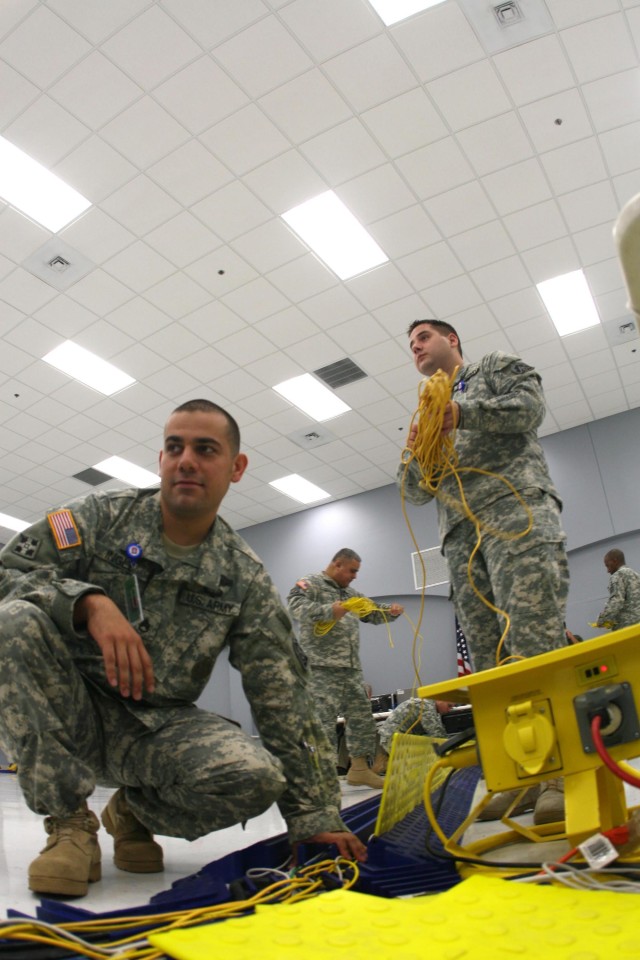FORT SAM HOUSTON, Texas - In preparation for Vibrant Response 2009, the Soldiers and their civilian partners of U.S. Army North's Task Force 51 worked diligently during a training exercise at Rudder Army Reserve Center in San Antonio, July 13 to July 24, to prepare for the command post exercise portion of Vibrant Response.
The Vibrant Response exercise will be conducted at Fort Leavenworth, Kan., from July 31 through August 14; it will focus primarily on responding to chemical, biological, radiological, nuclear and high-yield explosive incidents;
The exercise is designed to confirm the readiness and abilities of incoming forces that will fall under the CBRNE Consequence Management Response Force, effective Oct. 1.
During the "prep" session, Task Force 51 worked through identifying and resolving any potential issues with new equipment, setting up and tearing down their command post, conducting software training and creating new methods to better anticipate scenarios they may face during the exercise or, more importantly, a real-world event.
"Training before Vibrant Response is going to help us get into our battle rhythm so when we start working with the units that will fall under the CCMRF, we are better prepared." said Col. John Foster Jr., chief of staff, TF 51. "It is of absolute importance that we know our procedures and work with each of the units that will make up the CCMRF and that we are on the same page so that if a catastrophe does strike, we are better prepared to respond."
U.S. Army North, the Army Service Component and Joint Force Land Component Command for U.S. Northern Command, is charged with coordinating the federal military response in the land domain for domestic operations or disasters, to include CBRNE.
The bulk of the forces to fall under the CCMRF include the 218th Maneuver Enhancement Brigade, an Army National Guard unit out of South Carolina, the 330th Medical Brigade, an Army Reserve unit out of Fort Sheridan, Ill., and the 11th Theater Aviation Command, which is a mix of regular Army and Army Reserve units based out of multiple installations across the United States.
"Getting to work with these units will be very beneficial to us and the units under the CCMRF," said Staff Sgt. Orm Jenkins, military police officer, U.S. Army North. "Working as much as we have before the exercise is helping us help these units when we get to Vibrant Response.
"I am learning a lot and you always have to take every opportunity you can to train and learn."
Getting up to speed with the Command Post of the Future support system kept the task force busy learning about new operations capabilities.
Command Post of the Future was fielded by U.S. Army North three months ago and is designed to provide better situational awareness to commanders by providing collaborative tools to support decision making.
"We are always in the learning phase," said Ramon DeHoyos, training specialist, training management branch, U.S. Army North. "Even guys like me who have been here for 20 years always have something new to learn; and every time you do train, new challenges come up so it is important that we document it and learn from it."
The training was extremely beneficial to the task force and to Army North, said Foster, because it also provides the unit's new personnel a chance to get a feel for what will happen in Kansas.
"Around this time of year, we have a lot of new personnel coming into the headquarters so the two weeks of extra training gives them a chance to get their feet wet in the world of defense support of civil authorities and homeland defense operations," Foster said.
Staff Sgt. Darin Ingle had just arrived to U.S. Army North from the 3rd Brigade Combat Team, 4th Infantry Division, and was immediately thrown into the exercise as an operations noncommissioned officer.
"It really is a different side of the Army," Ingle said, about the transition from a brigade combat team to working in a unit that is focused on homeland defense and defense support of civil authorities. "I have learned quite a bit in the couple of days I have been here - but there is still so much to learn. I do feel better prepared for Vibrant Response because of this training."
Vibrant Response will challenge TF 51 to integrate smaller units from all military services as well as multiple government agencies into CCMRF operations.
"When we get a training venue like this, we have to take advantage of it," said DeHoyos, referring to the Reserve center. "The best part about exercises like this is when everyone goes out and trains to execute the mission working with the Federal Emergency Management Agency, state and local authorities, to assist the American people in a time of need.
"This preparation is definitely setting us up for success at Vibrant Response."




Social Sharing